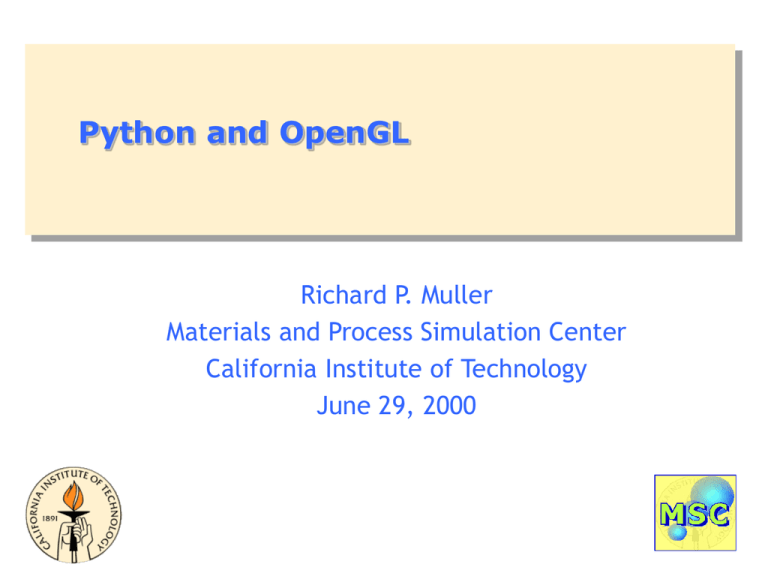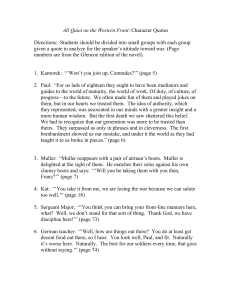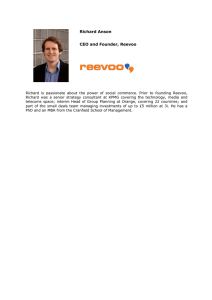Python and OpenGL
advertisement

Python and OpenGL Richard P. Muller Materials and Process Simulation Center California Institute of Technology June 29, 2000 What are 3D Graphics? • Traditional 2D graphics only store two-dimensional information – x,y coordinates – Images look like they're drawn on the screen • 3D graphics hold three-dimensional information – – – – x,y,z coordinates Transform image before drawn to screen Graphics boards accelerate the transformations Lots of special features are also enabled, most of which we'll ignore. © 2000 Richard P. Muller 2 What is OpenGL? • Silicon Graphics (RIP) created the Graphics Library – Sometimes referred to as DGL – Only ran on SGI Hardware • SGI made a open standard version of this – http://www.opengl.org – Licensed and ported to different machines • There is a free clone of the software available at – http://www.mesa3d.org – Can port anywhere © 2000 Richard P. Muller 3 OpenGL Family • GL – The basic GL library. Only primitive commands • GLU – "GL Utilities" – More complex commands, e.g. drawing cylinder • GLX – "GL for X-Windows" – Commands for drawing GL shapes in X • GLUT – "GL Utilities Toolkit" – More sophisticated windowing features, spheres, etc. © 2000 Richard P. Muller 4 Aside: OpenGL and Games • Game manufacturers like OpenGL – Quake, Diablo, etc. • OpenGL-compatible graphics boards are massed produced and become cheaper • No longer need $20k workstation to do molecular graphics! • Ending? Microsoft pushing people toward Direct3D... © 2000 Richard P. Muller 5 Caveats before we begin • We'll only look at a small subset of OpenGL – Balls – Sticks – Lighting • OpenGL is fairly difficult – We'll begin defining libraries to make it a bit easier – More help is welcome! © 2000 Richard P. Muller 6 Hello, World from OpenGL.GL import * from OpenGL.GLU import * from OpenGL.GLUT import * glutInit("Hello, World") glutInitDisplayMode(GLUT_DOUBLE | GLUT_RGB |GLUT_DEPTH) glutInitWindowSize(400,400) glutCreateWindow("Hello, World") glClearColor(0.,0.,0.,1.) glutSetDisplayFuncCallback(display) glutDisplayFunc() glutMainLoop() © 2000 Richard P. Muller 7 Hello, World Output • Yawn! © 2000 Richard P. Muller 8 OpenGL Callbacks • The line glutSetDisplayFuncCallback(display) defines a callback function. – Just like tk used callbacks last week. – "display" is the name of the function that draws the screen • Here's the display callback: def display(): glClear(GL_COLOR_BUFFER_BIT|GL_DEPTH_BUFFER_BIT) glutSwapBuffers() return – doesn't do anything yet – Uses double buffering © 2000 Richard P. Muller 9 Other OpenGL Callbacks • Mouse – The mouse interaction is setup using: glutSetMouseFuncCallback(mouse) glutMouseFunc() • Motion – The motion interaction is setup using: glutSetMotionFuncCallback(motion) glutMotionFunc() • Keyboard – The keyboard interaction is setup using: glutSetKeyboardFuncCallback(keyboard) glutKeyboardFunc() © 2000 Richard P. Muller 10 Building on Hello World • Hello, World didn't do anything other than poping up a window. • Obviously we want to do more sophisticated graphics • Display Lists are ways of holding objects to draw and redraw. – We can have multiple display lists and flip through them – Right now we're just going to create one – We'll also only just put one item on the list, which is a little silly, since display lists are made to do complicated renderings. – Display lists only have to be constructed once, which means that we can put all kinds of complex stuff on the lists and call it multiple times. – Items put on the display lists are also executed in C, and thus render quickly. © 2000 Richard P. Muller 11 Display Lists def init_display_list(): glNewList(list_number,GL_COMPILE) glPushMatrix() glTranslatef(0.,1.,-1.) #move to where we want to put object glutSolidSphere(1.,5.,5.) # make radius 1 sphere of res 5x5 glPopMatrix() glEndList() return def display(): glClear(GL_COLOR_BUFFER_BIT|GL_DEPTH_BUFFER_BIT) glCallList(list_number) glutSwapBuffers() return © 2000 Richard P. Muller 12 Sphere Output • Yuck! • What happened? – Didn't add lights! © 2000 Richard P. Muller 13 Lighting Models glEnable(GL_CULL_FACE) glEnable(GL_DEPTH_TEST) glEnable(GL_LIGHTING) lightZeroPosition = [10.,4.,10.,1.] lightZeroColor = [0.8,1.0,0.8,1.0] # greenish glLightfv(GL_LIGHT0, GL_POSITION, lightZeroPosition) glLightfv(GL_LIGHT0, GL_DIFFUSE, lightZeroColor) glLightf(GL_LIGHT0, GL_CONSTANT_ATTENUATION, 0.1) glLightf(GL_LIGHT0, GL_LINEAR_ATTENUATION, 0.05) glEnable(GL_LIGHT0) © 2000 Richard P. Muller 14 Output of Lit Sphere • A little more interesting... © 2000 Richard P. Muller 15 More interesting display list glNewList(1,GL_COMPILE) glPushMatrix() glTranslatef(0.,1.,0.) #move to where we want to put object glutSolidSphere(1.,20.,20.) # make radius 1 sphere of res 10x10 glPopMatrix() glPushMatrix() glTranslatef(0.,-1.,0.) #move to where we want to put object glutSolidSphere(1.,20.,20.) # make radius 1 sphere of res 10x10 glPopMatrix() glEndList() © 2000 Richard P. Muller 16 Define Cameras • Cameras let you define the specific viewpoint from which to look at the scene. – Let you do things like rotate, move in/move out, pan, etc. – Camera code: glMatrixMode(GL_PROJECTION) gluPerspective(40.,1.,1.,40.) # angle, aspect ratio, near clip, far clip glMatrixMode(GL_MODELVIEW) gluLookAt( 0,0,10, # camera position 0,0,0, # where camera points 0,1,0) # which direction is up glPushMatrix() © 2000 Richard P. Muller 17 Two sphere output • Finally starting to get a bit interesting • Now we can look at interacting with the spheres. © 2000 Richard P. Muller 18 Rotating the Graphics • We want to redefine our display(), mouse() and motion() functions so we can rotate the balls • Very simple code • Can also do scaling and translation the same way. © 2000 Richard P. Muller 19 Updated mouse function def mouse(button,state,x,y): global beginx,beginy,rotate if button == GLUT_LEFT_BUTTON and state == GLUT_DOWN: rotate = 1 beginx = x beginy = y if button == GLUT_LEFT_BUTTON and state == GLUT_UP: rotate = 0 return © 2000 Richard P. Muller 20 Updated motion function def motion(x,y): global rotx,roty,beginx,beginy,rotate if rotate: rotx = rotx + (y - beginy) roty = roty + (x - beginx) beginx = x beginy = y glutPostRedisplay() return © 2000 Richard P. Muller 21 Updated display function def display(): glClear(GL_COLOR_BUFFER_BIT|GL_DEPTH_BUFFER_BIT) glLoadIdentity() gluLookAt(0,0,10,0,0,0,0,1,0) glRotatef(roty,0,1,0) glRotatef(rotx,1,0,0) glCallList(1) glutSwapBuffers() return © 2000 Richard P. Muller 22 Output with Rotations © 2000 Richard P. Muller 23 Render Library • A framework for molecular 3d graphics • Render module – Inputs the files • RenderLib module – – – – – Canvas class: top-level drawing object Camera class: handles camera rotations Lights class Objects class: the display list EventManager class: the callbacks • RenderData module – Atom colors, radii, etc. © 2000 Richard P. Muller 24 Output from the Render library © 2000 Richard P. Muller 25 Final Thoughts • The commands aren't any easier in Python than in C • However, you don't have to worry about compiling or porting on different platforms – I run the same code on Windows98 and Irix-6.4 • This lets you focus on what you're doing with the rendering rather than the technology behind the rendering. © 2000 Richard P. Muller 26 References • Books – OpenGL Programming Guide, OpenGL Architecture Review Board, Addison Wesley – OpenGL Programming for the X Window System, Mark Kilgard, Addison Wesley • Web Pages – Python/OpenGL/Tk site: http://www.python.de © 2000 Richard P. Muller 27





